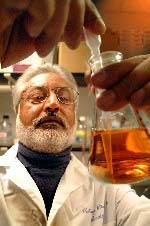
Animals in the oceans surrounding Antarctica are under increasing threat. Fishery management organisations and governments need to do more to eliminate illegal fishing and regulate better legal fishing in Southern Ocean and adjacent areas according to Professor John Croxall speaking today (17 Feb) at a special symposium – Conserving Migratory Marine Organisms: Protecting animals with ocean-sized habitats organised by the American Association for the Advancement of Science (AAAS).
Charismatic

A cell type with the potential for making the four major types of human tissue has been found in the stomach and small intestine by a Medical College of Georgia researcher.
These VENT cells have been found in addition to the three sources of cells typically associated with gastrointestinal development, says Dr. Paul Sohal, MCG developmental biologist, who first identified these cells nearly a decade ago.
Identification of VENT – ventrally emigrating neural tube – cells within the

Researchers at the University of Pittsburgh Cancer Institute (UPCI), in collaboration with Johns Hopkins University School of Medicine have found that a recently discovered gene plays an essential role in mediating apoptosis, or cell death, in colorectal cancer cells. The results are published in the Feb. 18 issue of Proceedings of the National Academy of Sciences.
The gene, PUMA, or p53 up-regulated modulator of apoptosis, is controlled by p53 – a tumor-suppressing gene that prevents norma

While the vision-impaired Hubble Space Telescope needed optical doctoring from shuttle astronauts, vision researchers back on Earth were wondering if the human eye was clever enough to fix itself.
Now a neurobiology study at Cornell University suggests that internal parts of the eye indeed can compensate for less-than-perfect conditions in other parts — either developmentally (during the lifetime of one individual) or genetically (over many generations).
Results of the study, “I

Broad implications seen for treating Alzheimer’s and other human diseases
By teaching fruit flies to avoid an odor and isolating mutant flies that can’t remember their lessons, researchers at Cold Spring Harbor Laboratory in New York have identified dozens of genes required for long-term memory.
In the same study, using DNA chip technology, the scientists identified another large group of candidate memory genes that are either switched on or off in the fly brain during memo

Gaiker y Santa Ana de Bolueta Abrasión, S. A., have developed a novel, rapid and efficient method to reduce abrasion in industrial parts.
The considerable wear suffered by industrial parts and equipment and by extracting tools that come into contact with abrasive materials forces companies to make periodic maintenance breaks in normal activity, thus causing considerable losses in time and money.
Santa Ana de Bolueta Abrasión, S. A., together with Gaiker, have developed a novel metho

– new calculation confirms standard model of particle physics. Contribution of hadronic vacuum polarization determined with unprecedented accuracy. The magnetic moment of the muon is an important precision parameter for…
Technique may prevent formation of unwanted waves that siphon off needed energy. Heating plasma to the ultra-high temperatures needed for fusion reactions requires more than turning the dial on a…

An international team of astronomers, led by researchers from the Astronomical Observatory of the University of Warsaw, have identified a new class of cosmic X-ray sources. The findings have been…

Antibody that Neutralizes Inhibitory Factors Involved in Nerve Regeneration Leads to Enhanced Motor Function after Acute Spinal Cord Injury. Researchers at 13 clinics in Germany, Switzerland, the Czech Republic and…

How the body’s natural killer cells could fight leukemia. Every year, some 13,000 people in Germany are diagnosed with leukemia. Despite intensive chemotherapy, around one in two of them die….

… eco-friendly reactor converts air and water into ammonia. Producing enough ammonia to feed the world comes with a large carbon footprint;. process described in new UB-led study could help…

How simulations help manufacturing of modern displays. Modern materials must be recyclable and sustainable. Consumer electronics is no exception, with organic light-emitting diodes (OLEDs) taking over modern televisions and portable…

“Neurons that fire together, wire together” describes the neural plasticity seen in human brains, but neurons grown in a dish don’t seem to follow these rules. Neurons that are cultured…

The quest for sustainable energy solutions has been a major focus of scientific research for decades. Solar energy, a clean and renewable source, has emerged as a promising alternative to…

With a processing speed a billion times faster than nature, chip-based laser neuron could help advance AI tasks such as pattern recognition and sequence prediction. Researchers have developed a laser-based…

New technology could remotely identify various types of plastics, offering a valuable tool for future monitoring and analysis of oceanic plastic pollution. Researchers have developed a new hyperspectral Raman imaging…

Artificial Intelligence (AI) has established a strong presence across industries, large and small. The “VoBaKI” research project has empowered small and medium-sized enterprises (SMEs) with an innovative tool to independently…